hnsc 1210 unit 5 - fats, oils, phospholipids, and sterols
1/97
There's no tags or description
Looks like no tags are added yet.
Name | Mastery | Learn | Test | Matching | Spaced |
|---|
No study sessions yet.
98 Terms
how to fats play an important role in health?
provide us with energy stores
insulating our bodies from extreme temperature
fats importance in food
providing texture and taste properties
lipids
organic compounds soluble in organic solvent but not water
term fat is more familiar than lipids
what is fat to the body
body’s chief storage space for excess food energy
helps us survive times of famine
fat cells expand to indefinitely store excess energy
provides us with large amount of energy to perform much of the body’s work
fat tissue
does more than store fat
secretes hormones that help regulate appetite and influences other body function’s
fat serves many other important factors in our body:
pads the vital internal organs, acting as shock absorbers
insulates the body from temperature extremes
is part of cell membranes
can be converted to other compounds (hormones, bile, vitamin D) as needed
fats in food serve important functions
provides essential nutrients (e.g essential fatty acids, fat soluble vitamins)
provides concentrated source of energy & raw materials for making needed products
provide tastes, smell, and a tender texture to foods
stimulates appetite and contribute to feelings of fullness
the usefulness of fats
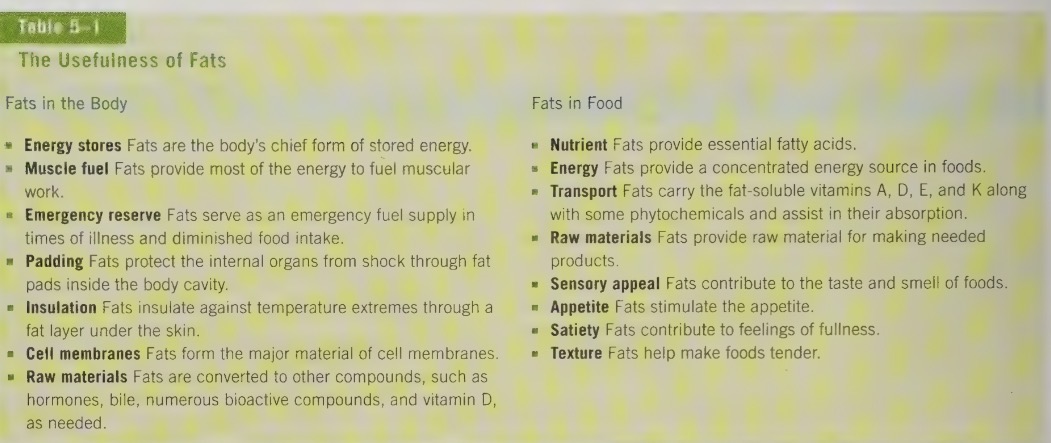
Recommendations for dietary fats
DRI: 20-35% from dietary fats
<10% energy from saturated fats
lowering saturated and trans fat intake helps to reduce blood cholesterol and thus heart disease
unsaturated fat reduced blood clotting
polyunsaturated fatty acids - DRI
5-10% energy from linoleic acid (omega-6)
0.6-1.2% energy from linolenic acid (omega-3)
cholesterol
DRI: minimize intake within context of healthy diet
only about 1/3 populations respond to lowering dietary cholesterol intake: limit eggs, shellfish, liver, etc. but these are nutritious foods
classification of lipids
triglycerides
phospholipids
sterols
triglycerides
when people speak of fat, they are usually talking about triglycerides.
major form of lipid found in the body and in food
made of 3 fatty acids and a glycerol backbone
triglycerides formation
most fatty acids are incorporated intro triglycerides, very few are found free in the body or in foods
glycerol is an organic compound 3-carbons long
each species makes its own characteristic types of triglycerides
fats in the diet can affect the type of triglycerides made because dietary fats are incorporated into triglycerides in the body
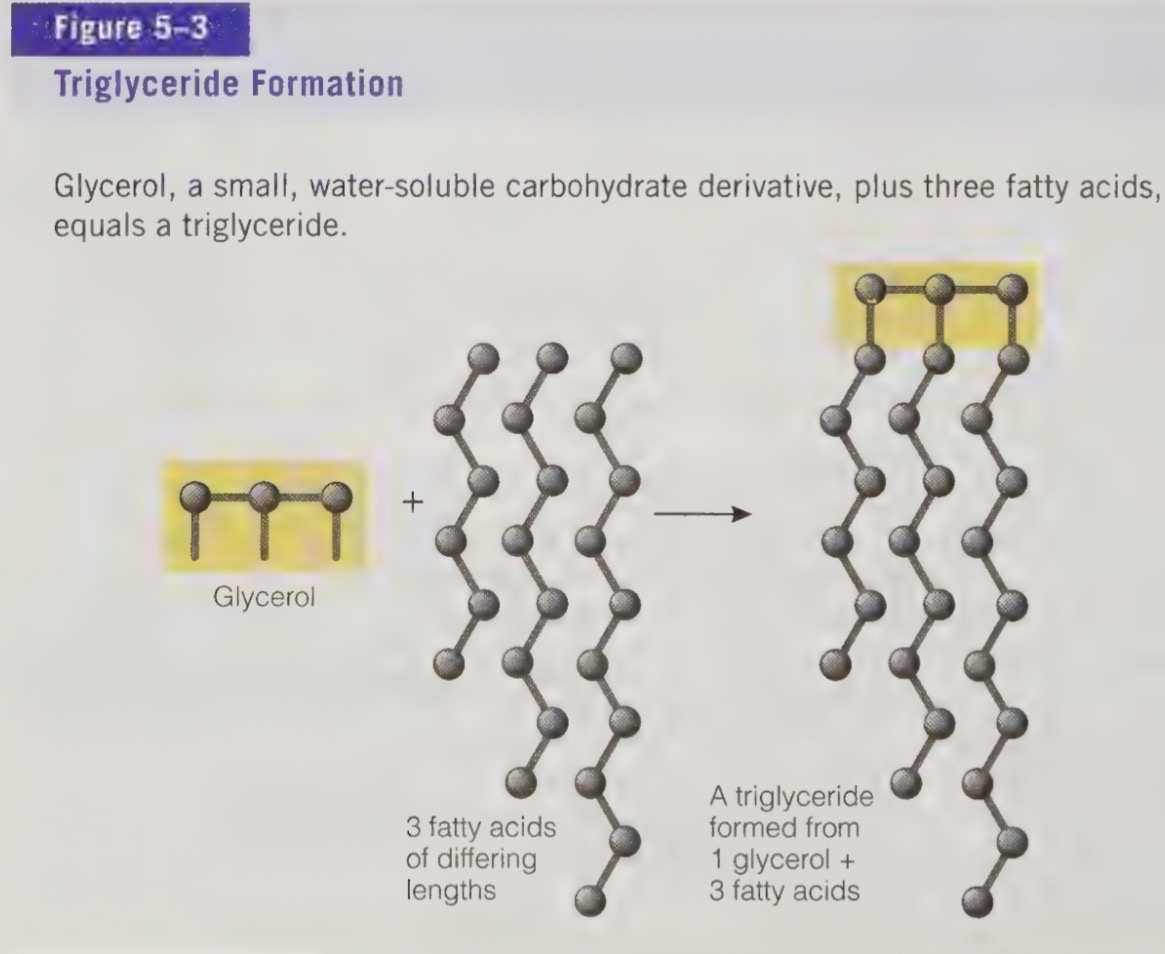
the fatty acids are classified by
a. chain length
short:< 10 carbons
medium:12-14 carbons
long:> 16 carbons
Shorter chain fatty acids tend to be softer and melt more readily at room temperature.
b. degree of saturation (double bonds, C=C)
three types of fatty acids
fatty acids can also be classified by degree os saturation
saturation refers to the number of hydrogen atoms a fatty acids chain is holding
the more hydrogen atoms attached, the more saturated the fatty acid is
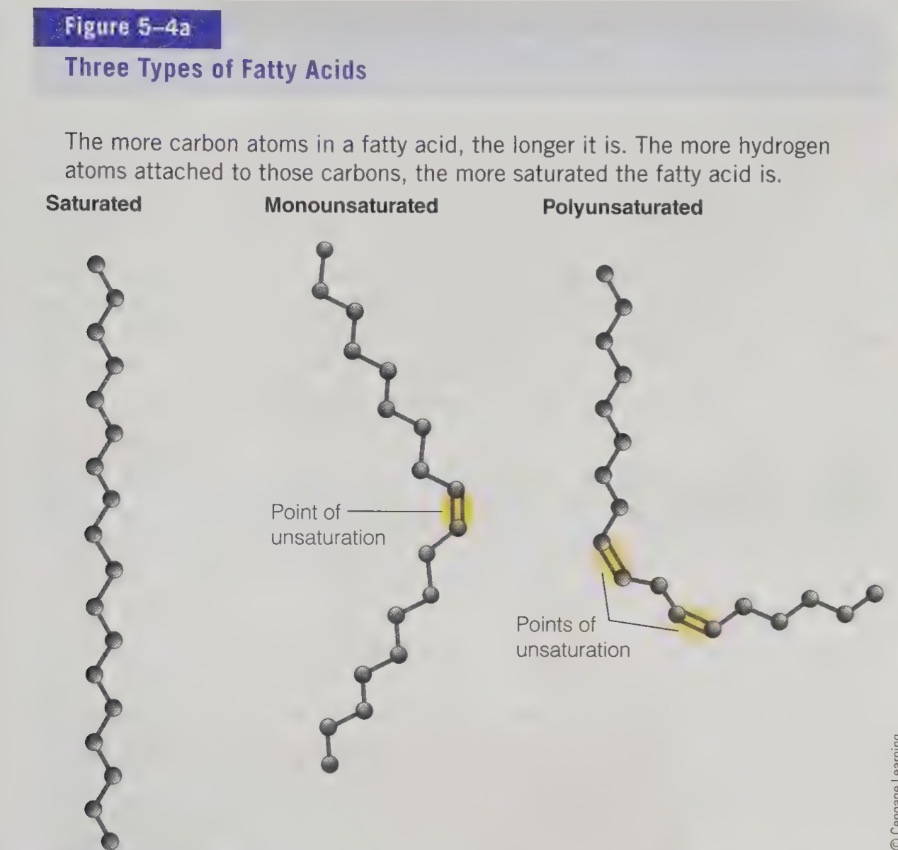
unsaturated
no hydrogen attached
double bond occurs
especially in fatty acids of plants and fish
saturated fatty acid
no points of unsaturated
tend to be solid at room temp.
animal fats (e.g butter, lard), tropical oils (e.g coconut oil, palm oil)
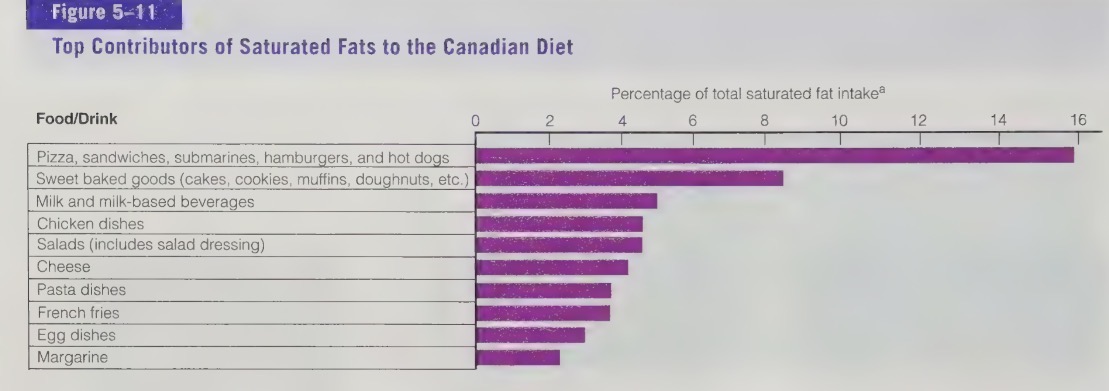
monounsaturated fatty acid (MUFA)
1 point of unsaturation
vegetable oils (e.g canola oil, olive oil)
polyunsaturated fatty acids (PUFA)
2 or more points of unsaturation
tends to be liquid oils at room temperature
vegetable oil and fish oil
fatty acid composition of common foods
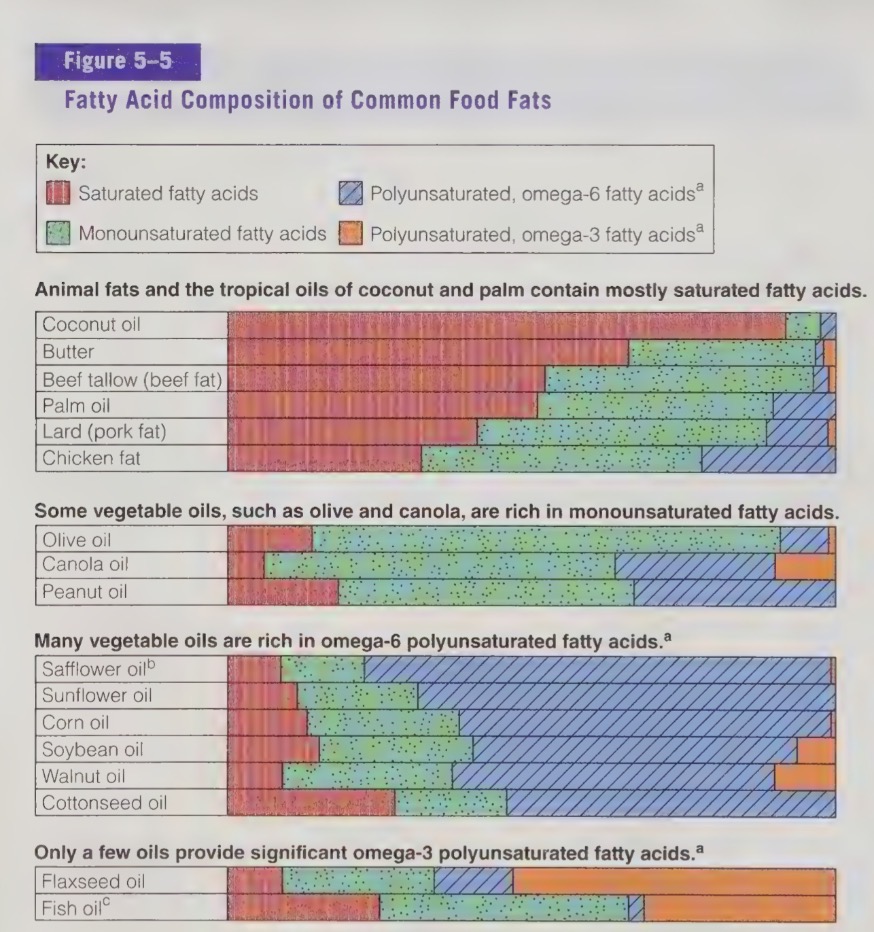
degree of saturation affects what in foods
temperature at which fat melts
more unsaturated the fat, the more liquid it tends to be at room temperature
animal fats are generally the most saturated and the hardest
researchers report benefit from replacing saturated and trans fat with mono and or poly unsaturated fats
saturated fats can increase your ‘bad’ blood cholesterol levels (LDL)
trans fat can increase your ‘bad cholesterol level (LDL) an decreased ‘good’ blood cholesterol (HDL), may increase risk or heart disease
effects of processing on unsaturated fats - margarines - A. hydrogenation
process where hydrogen is added to unsaturated fatty acids, to make a ore solid fat. e.g turning vegetable oil into hard margarine
process of hydrogenation
hydrogen attaches at the points of unsaturation (double bond) and the fatty acid becomes saturated (no longer has a double bond). makes fatty acid more solid at room temperature and increases shelf life
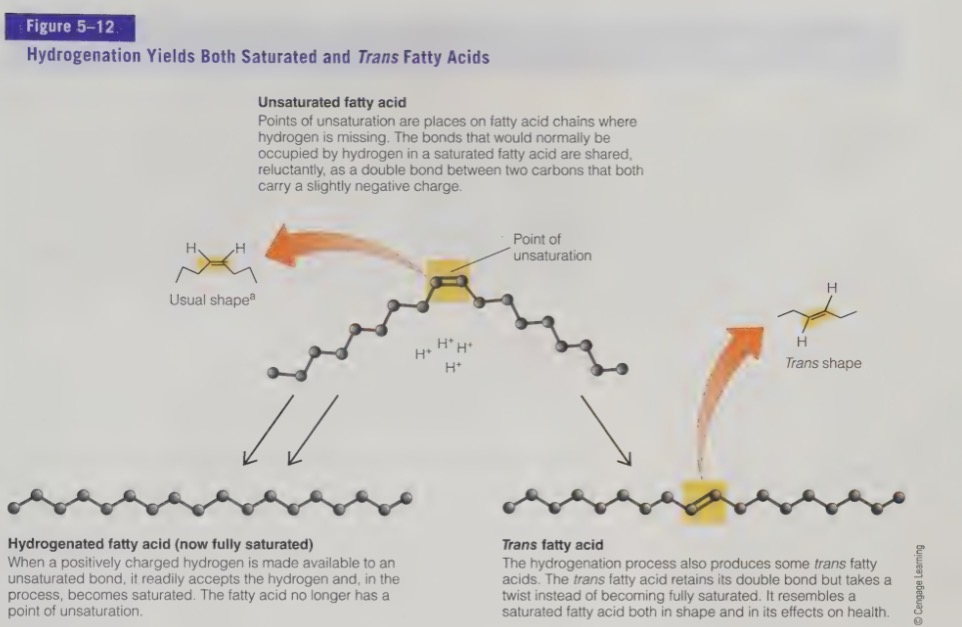
point of unsaturation are more vulnerable to oxidation
which is when oxygen mixes with fat, causing it to go rancid or taste “off”
store cooking oil in tight sealed containers
therefore, hydrogenated fats are more resistant to oxidation (as it no longer has points of unsaturation). more resistant to breakdown from high cooking temperatures and will have a longer shelf life
hydrogenated fats also have a higher smoking point and are more suitable for frying
when the hydrogen is added, some of the unsaturated fatty acids become…
more saturated and the oils hardens and becomes easier to spread
once hydrogenated the unsaturated fats lose their health benefits
problems with hydrogenation
affects not only the fatty acids in fat but the vitamins as well (ex. decrease vitamin K in body)
\
when unsaturated fatty acids are hydrogenated
some change shape instead of becoming saturated
creates unusually shaped unsaturated fatty acids look like saturated fatty acids
fatty acids referred to as trans fatty acids
consuming trans fats poses a risk to heart health and arteries by raising levels of bad cholesterol, and lowering levels of good cholesterol
also produced inflammation
DRI recommends consuming little trans fats as possible
health canada 2018
banned the use of partially hydrogenated oils in foods sold in candida, which as significantly reduced trans fats intake
b. blending different oils to produce “soft margarine”
can make margins to avoid creating trans fatty acids through a process of blending oils together.
creates soft, non-hydrogenated margarine (e.g Becel)
this product will not remain solid at room temp., however as the fats in this product are unsaturated
classification of lipids
phospholipids
sterols
phospholipids
Glycerol backbone + 2 fatty acids + phosphorus containing molecule
Water and fat soluble
Can serve as emulsifier
Examples - Lecithin is a phospholipid found in egg yolk. In mayonnaise, the lecithin blends the vinegar with the oil and keeps it from separating. Lecithin has no special health promoting abilities
the phosphorus molecule ales the phospholipid soluble in water
lectin supplements
available on the market that claim to lower blood cholesterol values, but these claims are not substantiated.
We can make all the lecithin our body needs (i.e., it is not essential).
emsulsifer
mixes with fat and water; allows fat to stay dispersed in water
cell membrane structures
phospholipids play a key role
sterols
large molecules consisting of interconnecting rings of carbon atoms, with side chain of carbon, hydrogen, and oxygen
cholesterol is an example of a sterol. cholesterol is important in the structure of cell membranes, therefore is part of every cell ad is necessary for optimal body function
whats good about cholesterol?
Cholesterol is necessary to make:
Bile – important for fat digestion
Vitamin D
Sex hormones, e.g., estrogen, testosterone
Stress hormones, e.g., epinephrine
whats bad about cholesterol
forms major part of the plaques that narrow the arteries in antherosclerosis, an underlying cause of heart attacks and strokes
cholesterol is made by the body so is therefore, not essential
lipid digestion & absorption - in the stomach
fat separated from the water chyme and floats on top of it.
fat does not mix with watery stomach contents, little fat digestion occurs in stomach
lipid digestion & absorption - in the small intestine
bile works to emulsify the fat with water digestive fluids because one end attracts and hold fats, while the other end is attracted to and held by water
by the time fat enters SI, gallbladder already squirted stored bile. bile them emulsifies and suspends the fat particles so that fat-digesting enzymes from the pancreas can split them into smaller particles for absorption
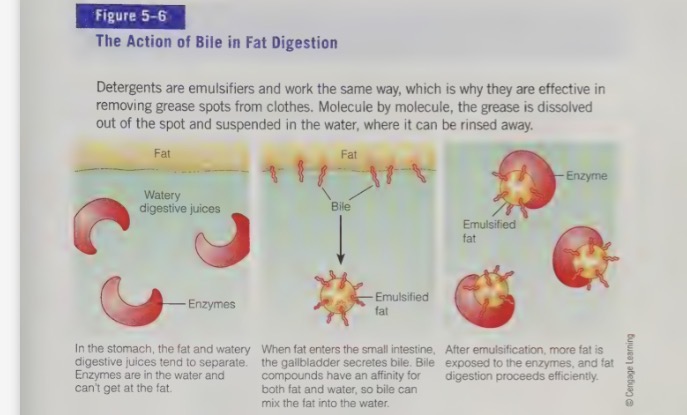
process of lipid digestion and absorption
mouth and stomach: little fat digestion
small intestine: digestive enzymes break down fat, bile emulsifies fat. enzymes cleave triglycerides into free fatty acids, glycerol, and monoglycerides
intestinal lining: parts absorbed. glycerol and short-chain fatty acid directly enters blood stream
4. cells of intestinal lining: convert large lipid fragments (mono) and long-chain fatty acids back into triglycerides and combine with protein forming chylomicrons that travel in lymph
large intestine: small amount of cholesterol trapped in fibre and exits with poop
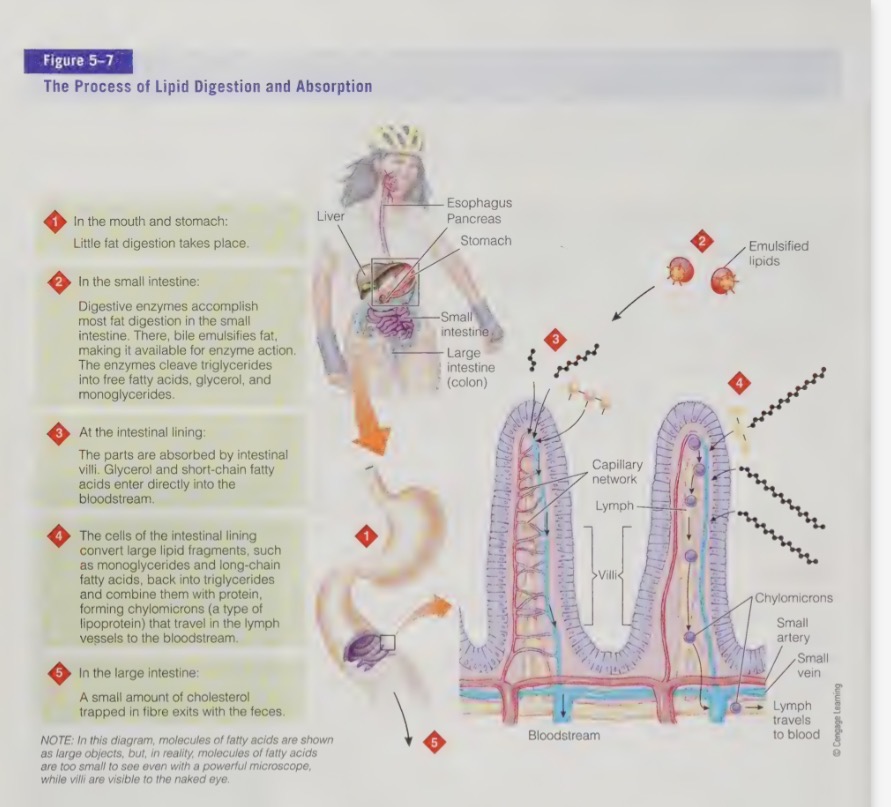
if gall bladder was removed
liver stops producing bile
bile continuously released into SI in small amounts
system can only handle small amounts of fat at a time
once intestinal contents are emulsified
fat spitting enzymes work on triglycerides to free fatty acids from glycerol backbone
free fatty acids, glycerol, monoglycerides cling together in balls surrounded by bile.
bile helps move fat across the watery layer of mucus coats the absorption lining
at the lining of the digestive tract
small lipid particles enter directly into the capillary network and travel unassisted to the liver.
large lipid molecules are re-formed into triglycerides in the intestinal cells and are packaged together with proteins and phospholipids to form chylomicrons, which can safely travel in the watery blood.
lipid transport - lipoproteins serve to move lipids in blood and lymph
chylomicrons
very low density lipoprotein (VLDL)
low density lipoprotein (LDL)
high density lipoprotein (HDL)
LDL are larger, lighter, and richer in cholesterol while HDL are smaller, denser and packaged with more protein
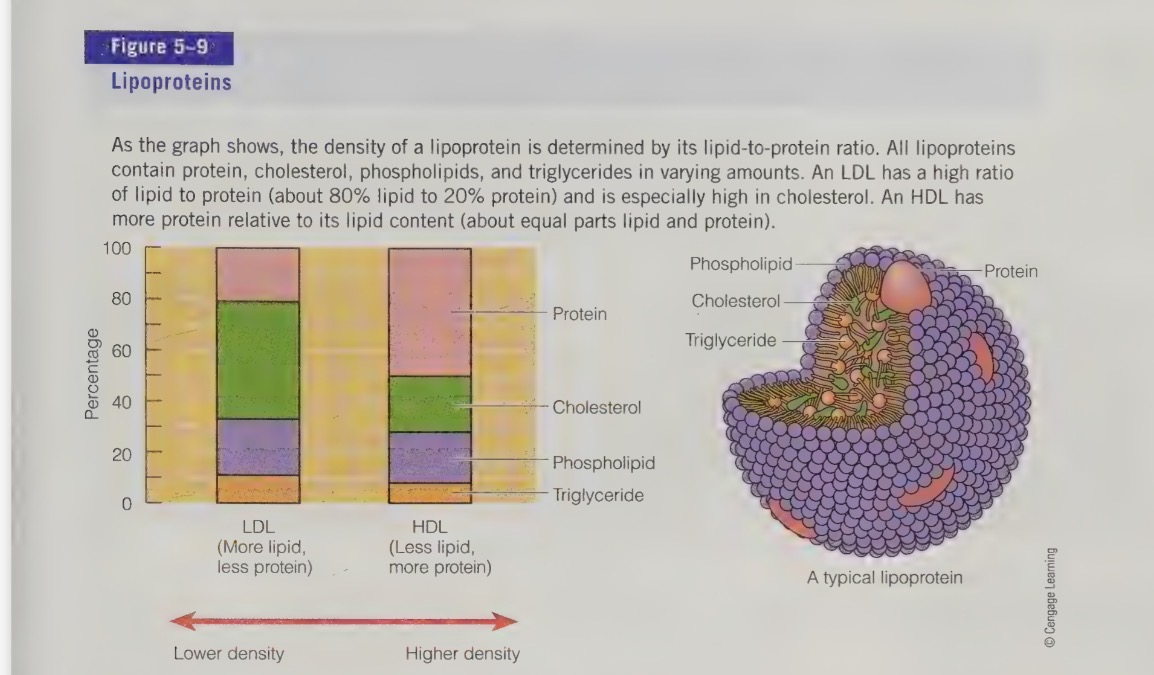
chylomicrons
clusters formed when dietary lipids combine with carrier proteins in the cells of the intestinal tract. They transport dietary fat through the water body fluids to the liver and other tissues.
very low density lipoprotein (VLDL)
transport triglycerides and other lipids from the
liver to various tissues in the body for use.
low density lipoprotein (LDL)
transport cholesterol and other lipids from the liver to other tissues (muscle, fat). LDL are made from VLDL after they have donated most of their triglycerides to body cells.
high density lipoprotein (HDL)
are critical in the process of carrying cholesterol away from body cells to the liver for disposal.
lipid metabolism
When the body starts to run out of fuel from food, it turns to body stores
Fatty acids are used for energy by many organs: typical fuel mix at rest is 50/50 carbohydrate/lipid for liver and muscle
Any time fat is broken down for energy, carbohydrate must be available
Otherwise ketones develop (products of incomplete fat breakdown) and build up in blood and urine
blood cholesterol & cardiovascular disease
High LDL levels increases risk for heart disease.
High HDL levels are associated with a low risk.
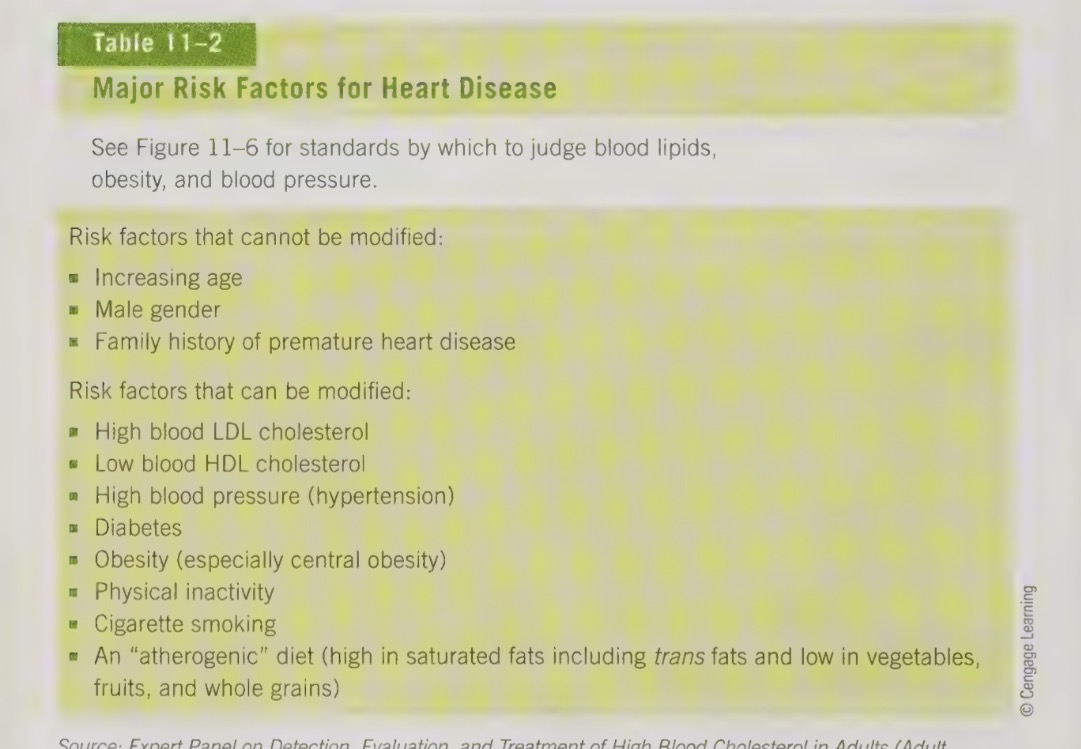
major risk factors for heart disease
High LDL cholesterol
Low HDL cholesterol
High blood pressure (hypertension)
Diabetes
Obesity
Physical inactivity
Smoking
A diet high in saturated and trans fats, and low in vegetables, fruits and whole grains.
cholesterol
important sterol in the structure of brain and nerve cells
part of every cell & necessary for functioning body
75-80% of our blood cholesterol is synthesized de novo (in the body)
though that sat fat trigger the body to produce cholesterol and trans fat may also play a role
limiting cholesterol-containing foods
does not pose risk for increased levels of blood cholesterol (in most people)
body adapts to slow it’s own cholesterol synthesis when diet provide greater amounts
some people have genetic tendency towards high blood cholesterol and must limit foods that are high in fat (sat and trans)
may require medicine to reduce the de novo synthesis of cholestrol
food cholesterol has less of an impact on blood cholesterol than most people think
dietary cholesterol
plays lesser role than sat and trans fat in cardiovascular disease
~60% exhibit little increase in blood cholesterol with high cholesterol diet
plays smaller but still significant contribution to blood cholesterol values
many foods higher in dietary cholesterol are also nutritious foods (I.e eggs, meat, cheese, animal derived foods) - don’t want to completely eliminate from diet
therefore moderation, not elimination is key
atherosclerosis
most common form of heart disease
Characterized by plaque development along artery walls
Starts with accumulation of soft fatty streaks, especially at points where the arteries branch.
Soft fatty streaks gradually enlarge and harden to form plaque
Damage the artery walls by narrowing the passage through them and making them inelastic.
plaques
mounds of lipids materials mixed with smooth muscle cells and calcium
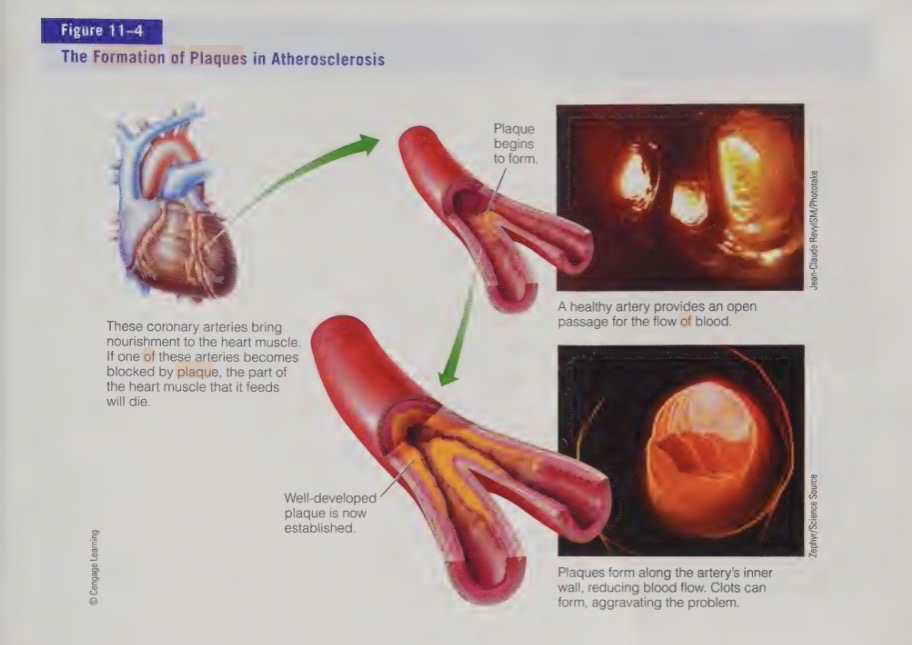
saturated fatty acids and cvd risk
replacing saturated fat with unsaturated fat reduced CVD risk. the reverse is also true: increasing saturated fat intakes increases the risk
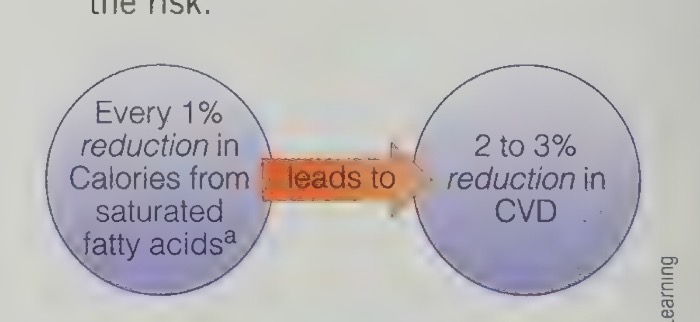
atherosclerosis develops through a complex inflammatory response to tissue damage
White blood cells (macrophages) are sent to the site of damage
LDL particles become trapped in blood vessel walls
Free radicals oxidize the LDL
Macrophages engulf oxidized LDL and become foam cells (filled with lipid) – these foam cells become a source of oxidation
Muscle cells in artery walls proliferate to try to heal damage
Muscle cells combine with foam cells
Fibrous plaques form (scar tissue)
problems associated with atherosclerosis
narrowing of arteries causes increase in pressure from blood flow
arteries become hardened and narrow by plaques - increased blood pressure
hypertension and atherosclerosis work together to worsen cardiovascular disease
artery walls hardened and narrow face stressed by high internal pressure
heart beat raise the blood pressure
fail to let blood flow freely through the kidneys (which control blood pressure)
kidneys sense low bp and react through low bp
atherosclerosis begins in early life
many people have well developed plaques by age 30
diet plays a role in reducing the risk of for plaque development
an atherogenic diet (high internal pressure heart sat fat, trans fat, cholesterol) increases LDL cholesterol whereas a well chosen diet ( low internal pressure heart fat and high in antioxidant nutrients) can lower CVD risk
increase HDL
maintain a healthy body weight
engage in regular physical activity
quit smoking
lower ldl
maintain a healthy body weight
increase intake of soluble fibre
reduce intake of saturated and trans fat
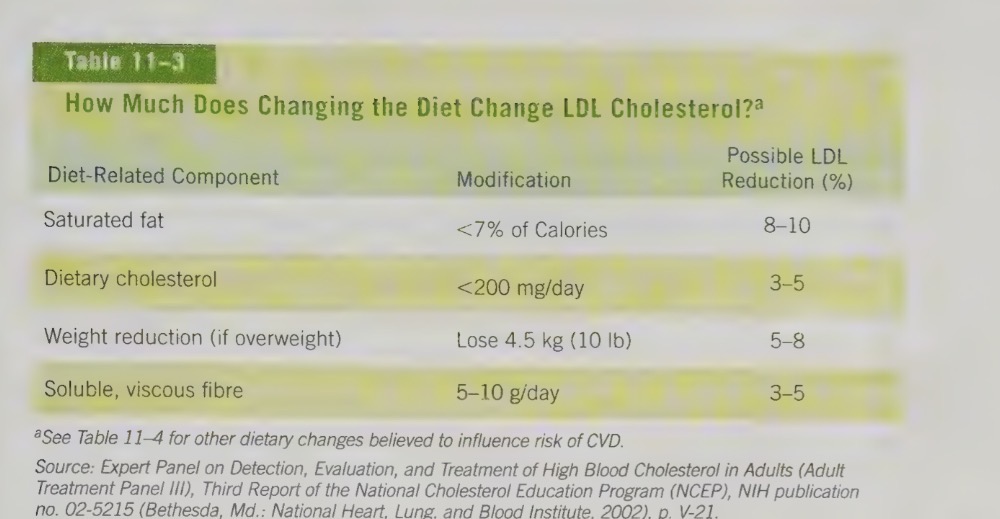
food fat, sat fat, & calories
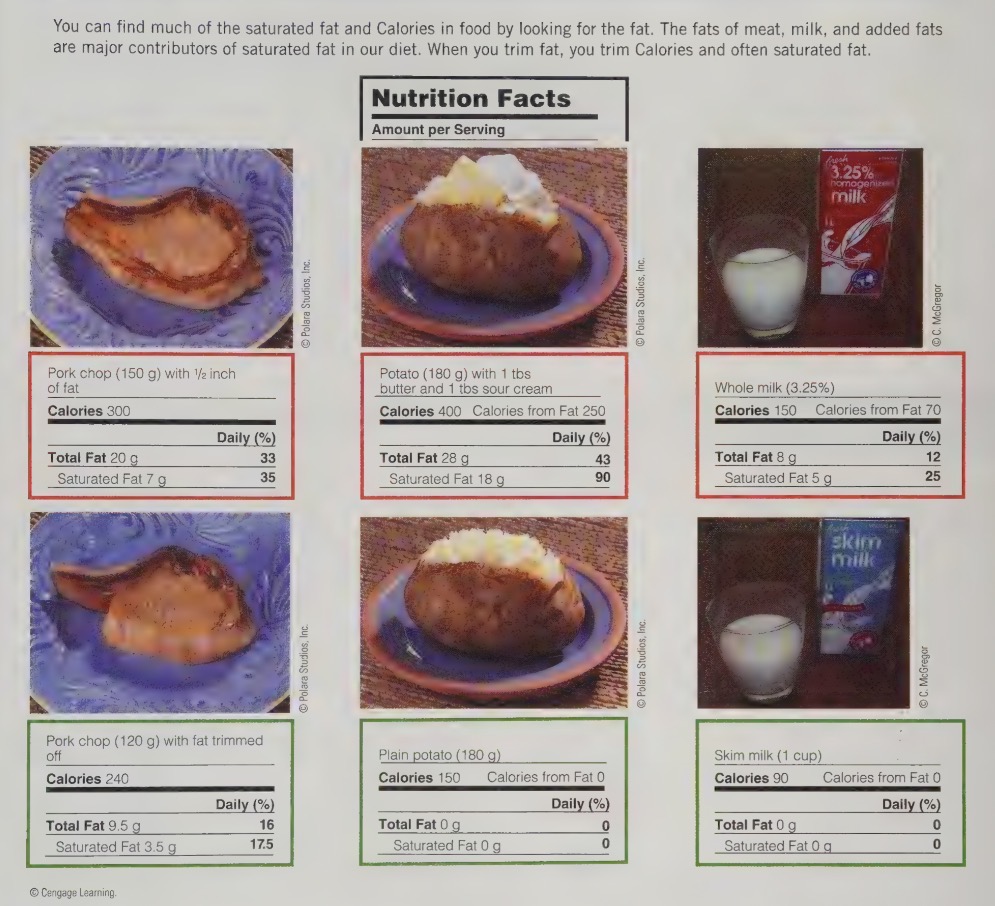
essential fatty acids (EFA)
fatty acids the body CANNOT make itself, must get from foods
2 types:
Linoleic acid (e.g omega-6 fatty acids)
Linolenic acid (e.g omega-3 fatty acids)
EFAs can be used by body to make eicosanoids
eicosanoids
biologically active compounds that regulate body functions
how do eicosanoids act somewhat like hormones
they effect muscle relaxation and contraction, blood vessel dilation & constriction, blood clot formation, blood lipid regulation, and immune response to injury & infection
EFAs have many functions
provide raw material for eicosanoids
serve as structural and function parts of cell membranes
contribute lipids to the brain and nerves
promote normal health growth and vision
assist in gene regulation
maintain outer structures of the skin thus protecting against water loss
help regulate genetic activities affecting metabolism
support immune cell function
research is showing EFAs benefit to improving cognitive abilities in infants
omega-6 (n-6) fatty acids
Omega-6 fatty acids get their name because of a double carbon bond 6 carbons from the end of its chain. Linoleic acid is an example of an omega-6 fatty acid.
DRI recommendation: 5-10% energy from n-6 fatty acids
Sources: vegetable oils, seeds, nuts, whole grain products
food sources of omega-6 and omega-3 fatty acids
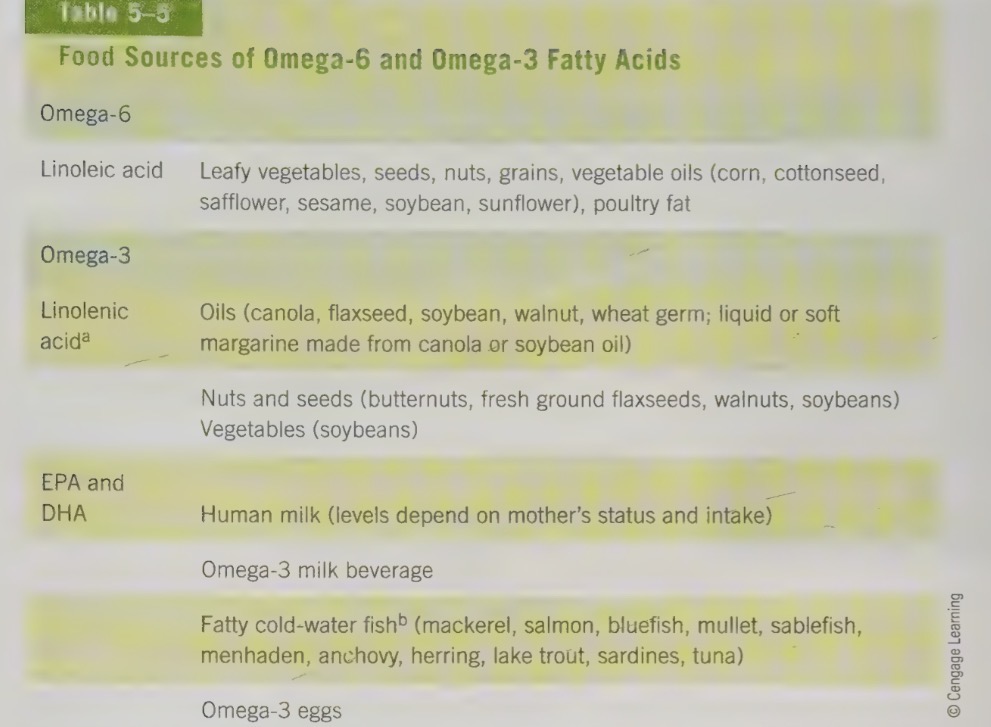
omega-3 (n-3) fatty acids
Omega-3 fatty acids get their name because of a double carbon bond 3 carbons from the end of its chain. Linolenic acid is an example of an omega-3 fatty acid.
DRI recommendation: 0.6-1.2% energy from n-3 fatty acids
Sources: flaxseed, flaxseed oil, canola oil, fish (especially deep sea fish)
research has shown that higher intake of omega-3 FA’s can often improve the health of the heart
three main types of omega-3 fatty acids
ALA (alphalinolenic acid) – from plant sources
EPA (eicosapentaenoic acid)– from fish sources
DHA (docosahexaenoic acid) – from fish sources
when given linolenic acid, te body can make other omega-3 FA’s
two specific omega-3 FA’s are receiving great interest from research -EPA and DHA
body only makes limited amounts of omega-3
found abundantly in oils of certain fish (deep sea, fatty fish like salmon, char, mackerel, herring, cod, etc.)
recommended to eat fish
high fat diets, had such low rates of heart disease
high marine based diet with abundance of fish and an abundance of these heart healthy fatty acids
EPA/DHA content tend to be higher in grilled, baked or broiled fish
fish used for frying in a fast food setting and in frozen products (ex. fish stick), tend to be species with lower DHA/EPA content
problem with supplements
it is preferred to get your EPA/DHA from food rather than supplements at this point
studies show greater benefit from the DHA/EPA in foods
fish oil supplements may raise LDL cholesterol levels in some individuals, and high intakes of omega-3’s (>3g/day) can increase bleeding time, interfere with wound healing and suppress immune function
supplements also lack other nutrients that fish provides (protein and minerals such as iodine, selenium)
fish oil supplements
may be made by skin and livers of fish, increasing contamination from pesticides, industrial contaminants and heavy minerals such as mercury
unless pill is refined to eliminate these, contaminants will become further concentrated in the pill
important to chose reputable brand
naturally contain high levels of two of the most potentially toxic vitamins, A&D, although many supplements companies remove these vitamins from their supplements
little is known about long-term effects of fish oil supplements
potential benefits of EPA/DHA
Heart disease (supported by most studies)
Mental health and cognition
Cancer (research promising, but need further evidence)
potential health benefits of fish oils
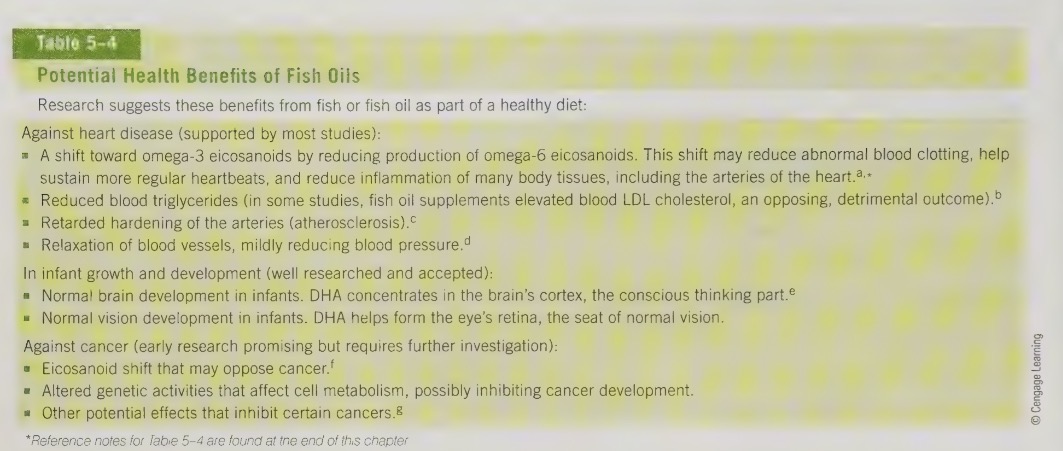
consumer’s guide: weighing seafood’s risks and benefits
need to know more about mercury in heart disease
people with pre-existing heart disease should choose fish species that have low mercury level to support their fish intake
fish that are more heavily contaminated tend to be larger fish that prey on smaller fish because the mercury builds up in their system
fish heavily contained with mercury
Shark
Swordfish
King mackerel
Fresh tuna steak (Albacore)
Tilefish
fish/seafood lower in mercury
Shrimp
Canned light tuna - Canned albacore (“white”) tuna contains more mercury than light tuna
Salmon
Pollock
Catfish
fish recommendations
consume a variety of fish
minimize exposure to any particular toxin that may accumulate in a particular fish species
pregnant women and children
most sensitive to the side effects of mercury
safely benefit from safer fish varieties within recommended limits
recommended weekly fish consumption
general population - 150g per week (eqv. to 1 cup)
specified women - 150g per week
children 5-11 years - 125 g per week
children 1-4 75g per week
fats in the diet
small changes in our food choices can drastically reduce our intake of dietary fat
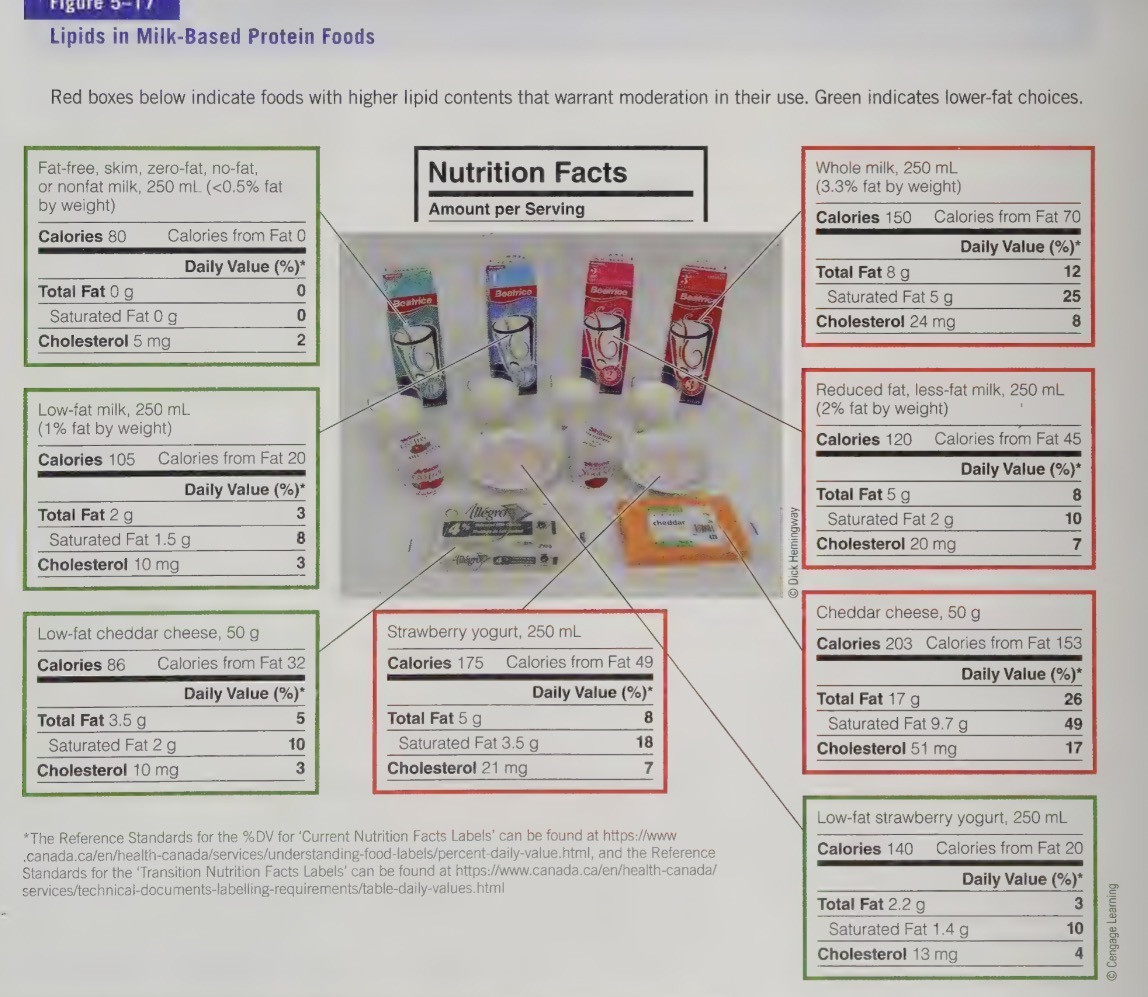
fats in the diet: ways to reduce saturated fat intake
watch how much fat you add to food (e.g salad dressing, mayo, butter/margarine, etc.)
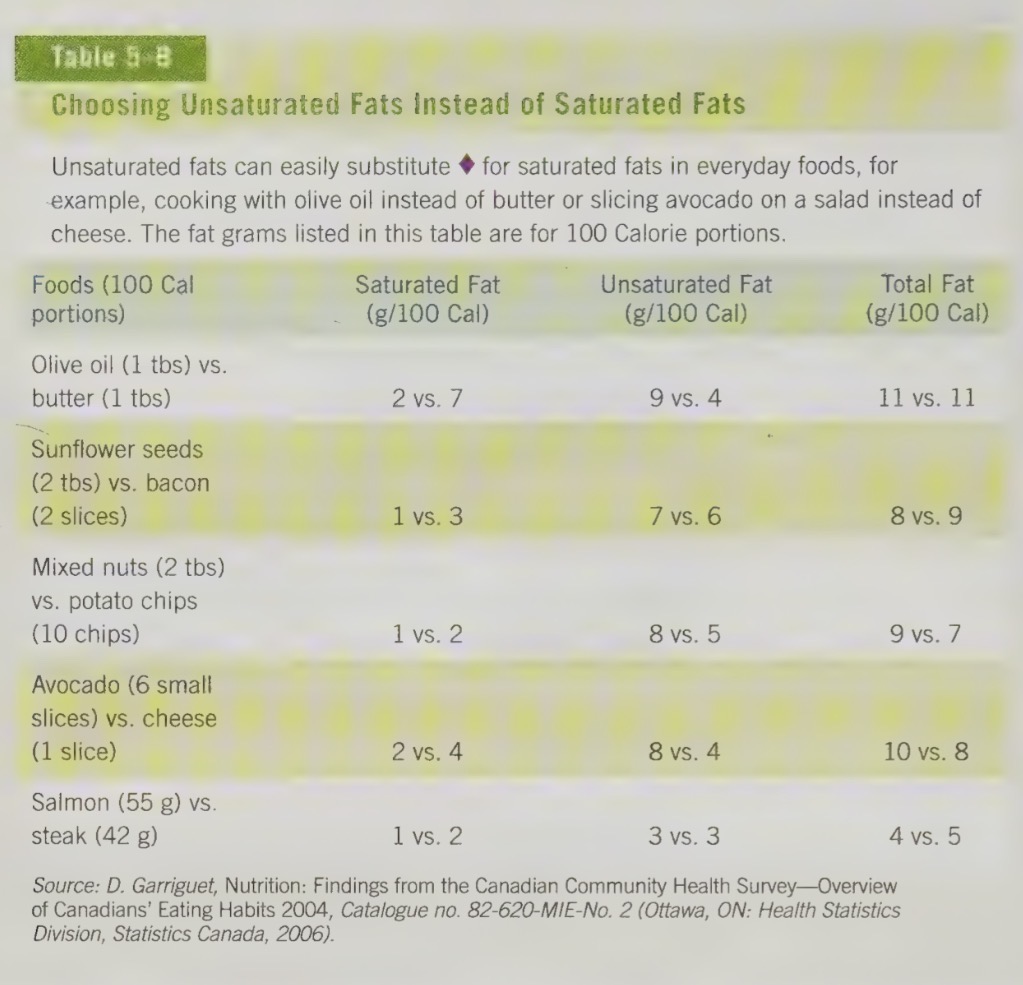
tips for dining our at restaurant
Watch the amount of sauces, salad dressings, oils and margarine that you add to food. Ask for sauces and salad dressings on the side at restaurants
Choose grilled, broiled, baked, stir-fried or poached foods instead of deep fried or fried foods.
Many restaurants have half portions of their meals. Choose these for portion control, or ask that the server only bring out half of the meal, and package up the other half for you to take home.
Share with a friend or family member. You do not have to give up all your favourite foods. Control portion size by sharing a higher fat entrée or high calorie dessert.
Avoid empty calorie beverages. Choose water or diet soft drinks instead of juice, regular soft drinks or iced tea.
artificial fats
Zero-energy fat replacers that are chemically synthesized to mimic the sensory and cooking qualities of naturally occurring fats, but are totally or partially resistant to digestion.
some products contain artificial fats while others use conventional ingredients in unconventional ways, or alter preparation methods to reduce fat and calories
alter preparation methods to reduce fat & calories
adding water or whip air into foods
adding non-fat milk to creamy foods
using lean products instead of high fat
baking rather than fry foods.
common food ingredients such as fibre, sugar/carbs, and proteins can take the place of fats - even tho provide calories, provide far less calories
to gain FDA consent to use fat replacers
proven that little energy is contributed
non-toxic
doesn’t build p in body tissues
doesn’t rob the body of essential nutrients
controversy 5: is butter really back? the lipid guidelines debate
Several problems can accompany low-fat diets:
It can be difficult to maintain such a diet
Such diets are not necessarily low-calorie diets (many people with heart disease are overweight and need to reduce body weight)
Diets high in carbohydrates (especially refined sugars) but low in fiber, may cause blood triglycerides to rise - unknown effects on heart health
Taken to an extreme, a low-fat diet may exclude nutritious foods that provide the essential fatty acids, phytochemicals, vitamins, and minerals. For example, fatty fish, nuts, seeds, vegetable oils contain beneficial fats, but are higher fat foods
seven countries study of healthy people
evidence around the world has led researches to question whether ow-fat diets are the best way to promote health
To summarize some of the results found
Death rates from heart disease were strongly associated with diets high in saturated fats
Death rates from heart disease were only weakly associated with diets high in total fat
Finland & the Greek island of Crete were the two countries with the highest fat intake
o Finland had the highest rate of death from heart disease
o Crete had the lowest rate of death from heart disease
Relative to Finland, people in Crete had a diet
High in olive oil
Low in saturated fat (Less than 10% of calories)
findings indicate that it isn’t total fat intake to blame for higher rates of heart disease, rather the type of fat consumed
dietary guidelines
Health Canada and the Dietary Guidelines 2015 concluded that research supports that saturated fat is of public health concern
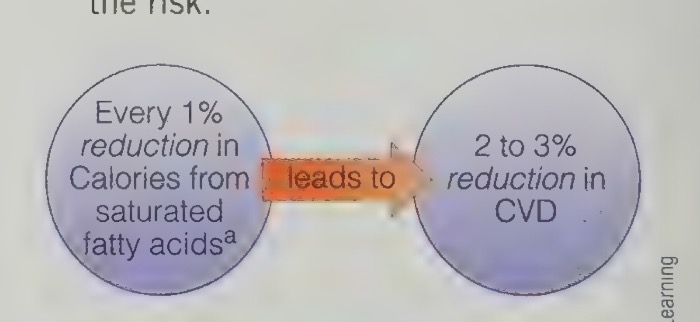
the debate
Some experts argue that saturated fat may not be as great of a risk because:
lack of biological mechanism
influence of a person's genetic inheritance on handling of fatty acids
differing actions of saturate fatty acids
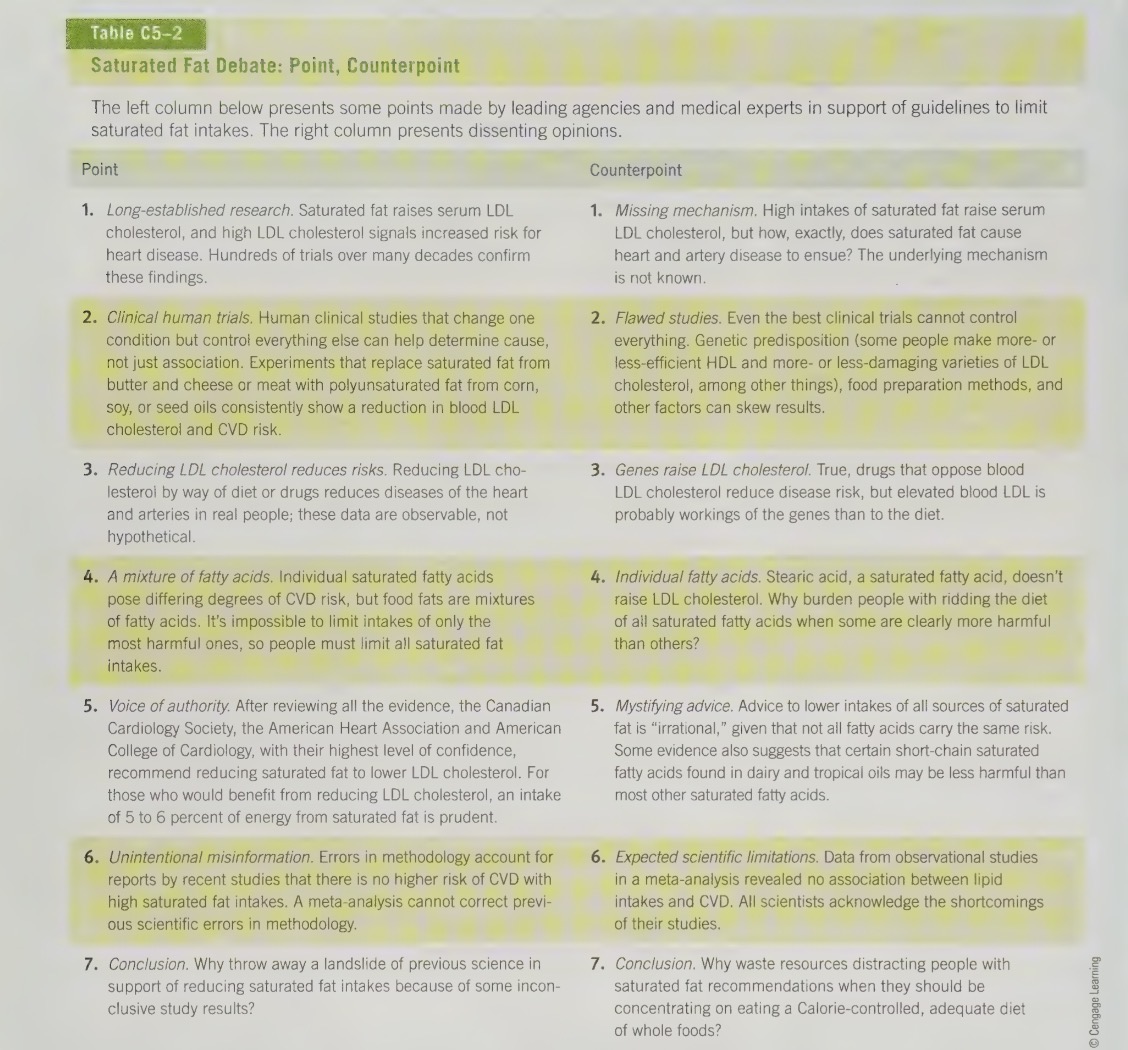
non-hydrogenated margarine
unsaturated fat - more heart healthy choice
non-hydrogenated margarines containing sterols or stanol esters (plant sterols) - reduction in cholesterol when used on daily bases
sterol esters act like a drug in the body and may have undesirable effects
some people cannot clear sterols esters from their blood and high blood concentrations may be linked to early signs of heart disease
may lower blood concentrations of carotenoids such as lycopene
butter
contains vaccenic acid - converted to conjugated linoleic acid (CLA) in the body
animals studies shown CLA to inhibit cancers, lower cholesterol, improve diabetes, improve immune function, potentially lower body fat
other studied have shown no effect or even negative effects so research on humans has been limited
hard stick margarine/ vegetable shortening
som contain large amounts of trans fat - up to 40% by weight
some brand reformulating their products to remove trans fat
non-hydrogenated margarine or butter?
taste
same calories and fat per serving
moderation is important
moderate intake of butter in healthy people ha negligible effects on health.
hard stick margarine and vegetables shortening contain rand fats should be avoided
research on dietary fats effect disease risk continues, eating pattern that is associated wth lower chronic disease risk
